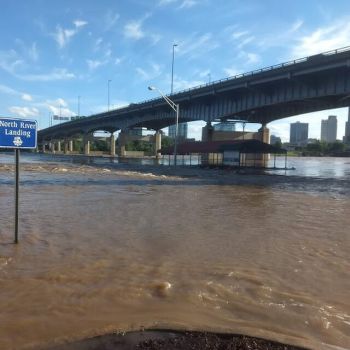Unexpected Changes in Water Level: Difference between revisions
Rmanwaring (talk | contribs) (Created page with "__NOTOC__ ---- <!-- Delete any sections that are not necessary to your topic. Add pictures/sections as needed --> [Paragraph here] ==Other Headings== Info ==Examples== {{Website Icon}} ==Best Practices Resources== {{Document Icon}} ==Trainings== {{Video Icon}} <!-- For information on notation for in text citations visit https://www.mediawiki.org/wiki/Help:Cite Or simply enclose the citation as shown <ref> citation </ref> in the location of the in text mention. Citati...") |
No edit summary |
||
| (2 intermediate revisions by one other user not shown) | |||
| Line 1: | Line 1: | ||
__NOTOC__ | __NOTOC__ | ||
[[Category:Risk Assessment Public Safety]] | |||
---- | ---- | ||
{{Picture | |||
<!-- Add image file name (ex.image.jpg) --> | |||
|image= Arkansas_River_Flooding.jpg | |||
<!--Add link if applicable --> | |||
|link= | |||
<!-- Add picture caption --> | |||
|caption= River flooding near Little Rock, Arkansas. | |||
(Image Source: [https://commons.wikimedia.org/wiki/File:Arkansas_River_Flooding_at_North_Little_Rock_May_2019.jpg Wikimedia]) | |||
}} | |||
<!-- Delete any sections that are not necessary to your topic. Add pictures/sections as needed --> | <!-- Delete any sections that are not necessary to your topic. Add pictures/sections as needed --> | ||
[ | Water levels on rivers, streams, and lakes can change quickly in a matter of hours or, in rare cases, even minutes. A number of potential factors can cause this ranging from changes in weather and rainfall to man-made releases of water. It is not always possible to anticipate changes in water level from previous rainfall, [[snowmelt]], or other natural processes. As bodies of water change, the behavior of the water flows and currents change as well. Small changes in water level or flow can create different behaviors in the area of a dam, potentially creating unsafe conditions such as much swifter currents or even a [[Hydraulic Roller|hydraulic roller]] in areas that were previously safe. Just because a river was safe yesterday or even in that same morning, does not mean it will remain so. | ||
Additionally, there are a number of reasons for man-made releases from upstream facilities. Industrial or manufacturing outputs may flush into a river, or an upstream dam may release some water. While some dam releases are preceded by a number of warnings including sirens, lights, and public announcement, it is always important to be aware of potential changes in water levels. Sudden changes can create fast moving and deadly floods or changes in behavior that can overwhelm unsuspecting people recreating or working downstream. | |||
<!-- For information on notation for in text citations visit https://www.mediawiki.org/wiki/Help:Cite Or simply enclose the citation as shown <ref> citation </ref> in the location of the in text mention. Citations will automatically populate below--> | <!-- For information on notation for in text citations visit https://www.mediawiki.org/wiki/Help:Cite Or simply enclose the citation as shown <ref> citation </ref> in the location of the in text mention. Citations will automatically populate below--> | ||
Latest revision as of 18:28, 19 July 2023

|
| River flooding near Little Rock, Arkansas.
(Image Source: Wikimedia) |
Water levels on rivers, streams, and lakes can change quickly in a matter of hours or, in rare cases, even minutes. A number of potential factors can cause this ranging from changes in weather and rainfall to man-made releases of water. It is not always possible to anticipate changes in water level from previous rainfall, snowmelt, or other natural processes. As bodies of water change, the behavior of the water flows and currents change as well. Small changes in water level or flow can create different behaviors in the area of a dam, potentially creating unsafe conditions such as much swifter currents or even a hydraulic roller in areas that were previously safe. Just because a river was safe yesterday or even in that same morning, does not mean it will remain so.
Additionally, there are a number of reasons for man-made releases from upstream facilities. Industrial or manufacturing outputs may flush into a river, or an upstream dam may release some water. While some dam releases are preceded by a number of warnings including sirens, lights, and public announcement, it is always important to be aware of potential changes in water levels. Sudden changes can create fast moving and deadly floods or changes in behavior that can overwhelm unsuspecting people recreating or working downstream.
Citations:
Revision ID: 7334
Revision Date: 07/19/2023
